Trilobite
Exoskeleton and Prosopon
(Exoskeletal Sculptural Features)
This page last revised 08 July 2007 by S. Gon III
|
All modern arthropods share a basic, three-layered structure to their exoskeletons, and well-preserved exoskeletons of trilobites exhibit this structure: an extremely thin outermost layer corresponding to the epicuticle of modern arthropods, but typically not well preserved, followed by a thin layer perhaps corresponding to the exocuticle of modern arthropods, and then a much thicker layer, which may correspond to the endocuticle of modern arthropods.Both layers are infiltrated heavily with low-magnesium calcite of considerable purity, even moreso than in modern calcified arthropods such as crustaceans. Underlying these secreted layers would be the living cells of the epidermis that generate the cuticular layers. This tri-laminate shell was very strong, and could be modified in thickness and shape. |
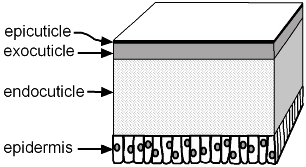 |
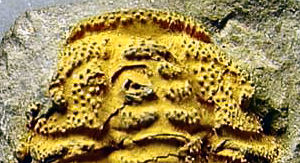 Tubercles on the
cephalon of Sao
hirsuta
|
As in modern arthropods, the trilobite exoskeleton frequently bore various spines, tubercles, nodes, ridges, and pits. These sculptural details are called prosopon, and refer to relatively small features, rather than the large genal, pleural, or pygidial spines that are hollow extensions of the main cuticle. Although sometimes referred to as ornamentation, this is not ideal, as it implies mere decoration. Instead, while the purpose of prosopon is not always obvious, they may have variously served as defense (spines), sensory organs (pits, nodes), structural strengtheners (polygonal ridges), feeding devices (pits), or to enhance friction while digging (terrace ridges). The amount and type of prosopon can sometimes assist in classification, but as in many morphological features, they cannot be universally applied. Below, several of the major categories of prosopon are discussed and illustrated (B&W photos mostly via Whittington 1992). |
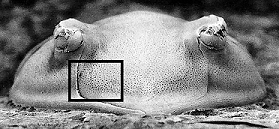 Pits in the shell of
an asaphid (detail at right)
|
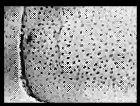 Detail
showing pits
|
Pits -- Small holes or depressions of various size can be found in a wide variety of trilobites, and are not restricted to any particular order or family. Sometimes these pits are very deep, extending all the way through the cuticle, and may have been occupied in life by sensory setae (hairs) that extended out of pits over the body of the animal. The tips of spines and tubercles sometimes show such pits. Some suggest that pits could have served a respiratory function, allowing oxygen exchange when the trilobite was completely enrolled. Larger pits, such as found in the fringes of Trinucleioidea (Order Asaphida), or Harpetidae (Order Harpetida) could have served in filter feeding (see example below). |
| Nodes -- Individual, raised, circular or oval areas, typically medial, are reported from a variety of trilobites, as in the example Triarthrus (right). Nodes may be dome-shaped, conical, or can be extended into spines. Certain trilobite groups are characterized by particular kinds of nodes. For example, families Asaphidae and Nileidae in the order Asaphida, and Illaenidae in the order Corynexochida bear preoccipital nodes. In the cyclopygoids Pricyclopyge and Symphysops a pair of axial structures on one thoracic segment appear as domes or nodes with concave centers, that have been ascribed sensory (perhaps visual) function. | 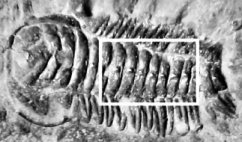 Axial nodes on Triarthrus (detail right)
|
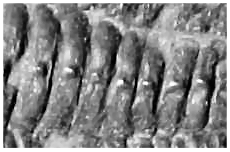 Detail of box in
image left.
|
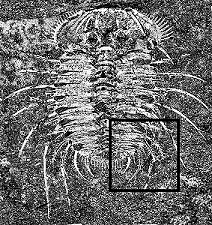 |
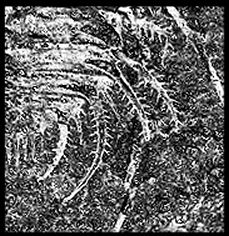 |
Spines --
Many trilobites bear spines, and the most common interpretation of
their function is defense against predation. Recall that large
spines such as genal spines and main thoracic or marginal pygidial
spines are not
considered prosopon, but finer spines (such as the spines on spines
shown at left)
qualify. Sometimes there are pits along and at the tips of larger
spines, where sensory hairs may have been present. Certain groups of
trilobites can be particularly spinose, such as the Odontopleuroidea
(Order Lichida), and some
Acastoidea (Order Phacopida).
As was mentioned earlier, axial spines can grade smoothly into nodes,
and shorter spines are essentially sharp-tipped (spinose) tubercles.
During ontogeny
of there can be spinose stages, followed by metamorphosis into
stages with reduced or spineless exoskeletons. . Left: Miraspis mira (Odontopleuridae) and close-up. |
| Tubercles -- Numerous prominences of small to medium size that cover broad areas of exoskeleton are called tubercles (contrasting with nodes, that are typically singular and axial). Tubercles are often somewhat variable in size, and sometimes there are two main size classes of tubercles present, with larger tubercles surrounded by smaller ones in intervening spaces. Although tubercles can be found in a wide range of trilobite families (e.g., on Scutellum (right), family Styginidae, suborder Illaenina, order Corynexochida) they are particularly well developed among the Order Lichida and Phacopida. When tubercles are very small they are sometimes referred to as granules. Tubercles may have been combined with coloration to offer textured camouflage for a trilobite. It has even been suggested that tubercles could have helped trilobites escape from nautiloid predators, whose suckered tentacles could not grip a tubercled surface as easily as a smooth one. Tubercles can be dome-shaped or spiniform, and there often is a transition between spiniform tubercles and true spines on individual trilobites. | 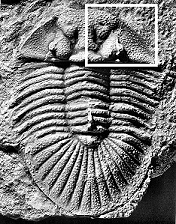 |
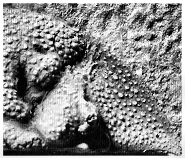 Enlargement of box
(left),
showing tubercles over much of the cephalon. after Whittington 1992 |
| Ridges -- Linear, raised features, both symmetrical and asymmetrical in profile, sometimes characterize the exoskeleton. When the ridges are fine, parallel, and symmetrical they are called lira, as in the nileid trilobite Peraspis lineolata (right). Some bathyurids, proetids, and remopleuridids exhibit lirae in a fingerprint-like pattern called the Bertillon pattern. However this pattern can vary, and the symmetrical lirae can grade into an asymmetrical type of ridge called terrace ridges (see below). | 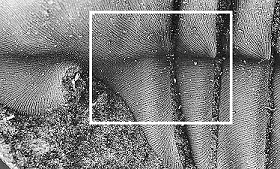 |
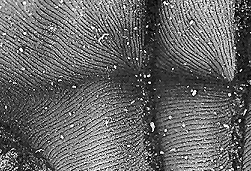 |
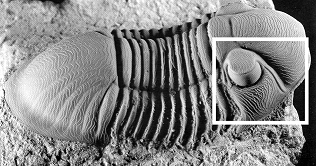 Terrace ridges on a
specimen of Paralejurus.
|
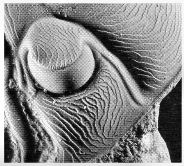 Detail of box in
image left.
|
Terrace ridges, such as those seen on Paralejurus (left) are so called because they resemble terrace lines on a contour map. Such terrace ridges are typically found on otherwise effaced trilobites such as Illaenidae (Order Corynexochida) or Asaphidae (Order Asaphida). In the Illaenidae in particular, it is suggested that the ridges help provide unidirectional resistance against fine silt and sand while the trilobite is burrowing. Indeed, the terrace ridges are often particularly well developed on the ventral exoskeleton (on the doublure and even the hypostome) and along the lower dorsal edges. |
| Polygonal ridges form a network of small polygons in the exoskeleton, sometimes surrounding pits, as in the example at right (black box); a ridge network on the glabella of a trinucleiid. In this case, the network structure might greatly strengthen the convex vault of the glabella, or the pits might be related to a cluster of sensory hairs at the front of this blind species. Notice how at the edge of the polygonal ridge network, there are small pits that are not surrounded by ridges. Another prosopon element, large pits on the cephalic fringe (white box), characterize both superfamily Trinucleioidea (Order Asaphida) and family Harpetidae (Order Harpetida). They may have been involved in filter-feeding behavior. | 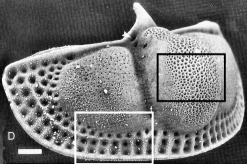 Polygonal ridges (black box) and large pits (white box) on a trinucleiid cephalon. |
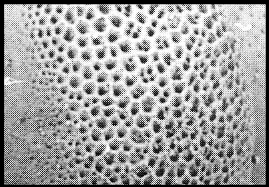 Detail of black box
(left)
|
Prosopon and Classification
Some of the examples above suggest that prosopon can assist in determining the classification of a trilobite specimen. However there are always exceptions to a general rule, and prosopon alone cannot serve as a failsafe diagnostic. For instance, although Lichida are often heavily tubercled or spined, there are some smooth examples. Because exoskeletal sculpture is an important adaptive feature, and because the cuticle of all trilobites is a shared character, it stands to reason that certain kinds of prosopon may develop independently in a broad array of groups that are exposed to the same selection pressures. We end here with a few more examples of prosopon in a variety of trilobite specimens:
|
Tubercles & Spines
Hoplolichoides (Order Lichida) 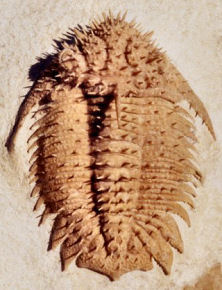 |
Ridges
Harpides (Order Harpetida) 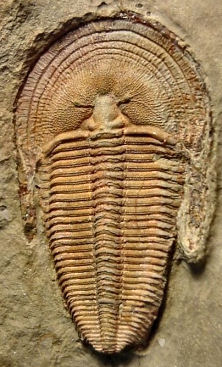 |
Pits
Cryptolithoides (Order Asaphida) 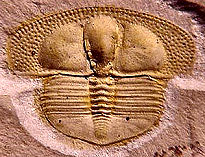 |
Paired Nodes
Pricyclopyge (Order Asaphida) 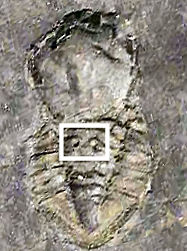 |
.
Fortey, R. A. & R. M. Owens. 1999. The Trilobite Exoskeleton. in: Functional Morphology of the Invertebrate Skeleton. John Wiley & Sons.
.
Whittington, H.B. 1992. Trilobites (Fossils Illustrated). Boydell Press, Woodridge.
.
Whittington, H.B. & N.V. Wilmot. 1997. Microstructure and sculpture of the exoskeletal cuticle. In: Kaesler, R. L., ed. Treatise on Invertebrate Paleontology, Part O, Arthropoda 1, Trilobita, revised. Volume 1: Introduction, Order Agnostida, Order Redlichiida. xxiv + 530 pp., 309 figs. The Geological Society of America, Inc. & The University of Kansas. Boulder, Colorado & Lawrence, Kansas.
